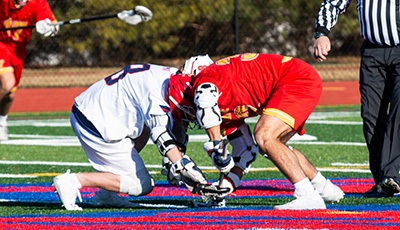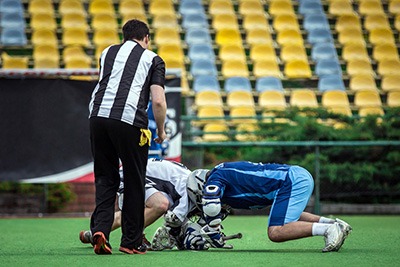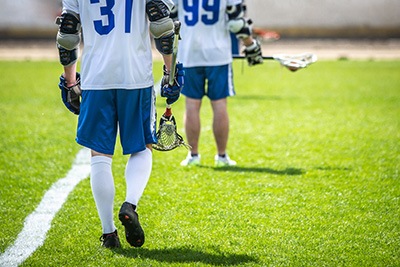Contact rules dictate the amount of physical contact allowed within a sport, and for lacrosse, it is no different.
As one of the fastest sports among team-oriented games, finding a balance between safety and fun can sometimes be challenging.
This guide seeks to answer the question: Are fights legal in lacrosse?
By exploring contact rules and the latest updates in 2023, we can better understand what is considered acceptable during matches.
More...
Take Away Key Points:
Why is fighting discouraged in lacrosse?
Good lacrosse is a fast-paced and physical sport, but it is not a contact sport like ice hockey or football. As a result, fighting in lacrosse is highly discouraged and can lead to serious consequences for those involved. While some may argue that fighting adds an element of excitement to the game, it can also be dangerous for other players and have long-term repercussions on their careers.
Fighting and dirty play in lacrosse can result in suspensions, fines, and even criminal charges depending on the severity of the altercation. It also sets a bad example for younger players who look up to professional athletes as role models.
Furthermore, fights can disrupt the game's flow and take away from the focus on skill development that makes lacrosse so enjoyable to watch.

Are fights legal at youth, high school & college level lacrosse?
Is fighting allowed in lacrosse? The answer to this question depends on the level of play.
At the youth lacrosse, high school, and collegiate levels, fighting is not allowed in lacrosse. Professional box lacrosse (NLL) and professional field lacrosse (MLL) are the only two levels where fighting is allowed.
In most cases, a player who engages in a fight will be given a penalty or suspension. This is because lacrosse is a contact sport, but it should never become violent or dangerous. Players should always respect each other and focus on playing the game safely and fairly.
At the professional level, fighting is regulated by specific rules designed to keep players safe while allowing them to compete aggressively. For example, players must wear protective equipment such as helmets and gloves when fighting. They also must follow specific guidelines for how long they can fight before being ejected from the game.
Overall, it's important to remember that fighting has no place in lacrosse at any level of play. Instead, players should always strive to maintain sportsmanship and respect for their opposing team while playing the game safely and fairly.
Are fights legal in box lacrosse (National Lacrosse League)?
Fights are allowed in box lacrosse, also known as the NLL. According to the NLL rulebook, a fight is "an altercation between two or more players in which punches are thrown".
Recently, the Canadian Lacrosse Association increased the penalties and changed the rules for fighting in most box lacrosse leagues. When two guys fight in indoor lacrosse, both will receive penalties and be ejected from the game.
In NLL games, players who engage in a fight will be penalized and suspended. A player who starts a fight will receive an automatic game misconduct penalty and can be suspended for up to five games. Players who join in on the fight after it has started will receive a game misconduct penalty and can be suspended for up to three games.
It's important to note that fighting is not allowed at any other levels of pro lacrosse, including youth, high school, and collegiate levels. At these levels, any player who engages in a fight will be subject to disciplinary action from their respective governing body.
READ MORE
Are fights legal in professional field lacrosse (PLL)?
Professional Field Lacrosse (PLL) is a professional sport that has been gaining popularity in recent years. While fighting is not allowed at the youth, high school, and collegiate levels of pro lacrosse, it is allowed in professional box lacrosse (PLL).
In the PLL, fighting is regulated by the league, and players can be fined or suspended for engaging in a fight. For example, the rules state that if two players drop their gloves and throw punches at each other, they will both be ejected from the game. Additionally, any player who instigates a fight can face further discipline from the league.
Despite these regulations, fights still occur in professional box lacrosse games. For example, in December 2021, two goalies got into a wild fistfight during an NLL game that caught on video and quickly went viral. The fight included multiple uppercuts, haymakers, and some wrestling moves. Although it horrified many lacrosse fans, the move actually raised a lot of interest in the subject.
Ultimately, it's up to PLL to decide how they want to handle fights in their league.
Are fights legal in major league lacrosse (MLL)?

Fights are not legal in MLL. The US Lacrosse organization unwaveringly enforces a zero-tolerance policy for fighting, considering it unacceptable behavior that should not be tolerated in any game.
As part of this stance, any US Lacrosse game must abide by rules that strictly forbid any form of physical contact deemed excessive or retaliatory.
For this reason, MLL teams must ensure that all their players understand and adhere to the game's rules to prevent any acts of violence from occurring.
Additionally, to reinforce their no-fighting policy and ensure safety amongst players, MLL officials carry out proactive strategies when needed and respond immediately if a fight ensues.
How far can you take fighting in lacrosse?
In youth, high school, and collegiate pro lacrosse, fighting is not allowed under any circumstances, and players who engage in fighting will be ejected from the game. Additionally, players may face other disciplinary action depending on the severity of the altercation.
In professional box lacrosse (NLL), fighting is allowed as long as it is not premeditated or excessively violent. Fights between two players will result in both players being ejected from the game, and fines/suspensions can be handed down from the league for instigating a fight or throwing multiple punches at an opponent.
What happens when a fight occurs?
When a fight occurs during lacrosse, the referee will usually separate the players and assess penalties for each individual involved.
Depending on the severity of the altercation, suspensions or even criminal charges may be handed out to those responsible. The team at fault may also face fines or loss of points.
In addition, referees and leagues may take additional action against fighting by placing warnings or bans on teams or players.
Fighting can have long-term repercussions for players and coaches alike, so it is essential to take all necessary steps to prevent any altercations from occurring during games.
In most cases, following proper sportsmanship guidelines and refraining from any physical contact is the best way to help reduce the risk of fights breaking out in lacrosse.
Penalties & regulations of fighting in lacrosse
Lacrosse is a popular sport featuring high-intensity play and physical contact, so participants need to know the rules of their sport.
Fighting carries serious penalties and can lead to suspensions. Depending on where the game is played, referees can expel offenders from a single match or even take away whole seasons of games from offenders if necessary.
For those participating under NCAA rules, any fight or malicious contact carries an automatic suspension that ranges from half a season to a full year and can even go higher for successive offenses.
Players are also not allowed to use lacrosse equipment as weapons and face much stricter punishments than if they had been using their fists or feet.
As with all sports, fighting in lacrosse should be avoided at all costs - it hurts the players involved physically and mentally and punishes the teams they play on too.
What is considered forbidden physical contact in lacrosse?
Physical contact is an integral part of the game of lacrosse, but certain forms of contact are forbidden and can lead to serious consequences if violated.
The most common infractions related to physical contact include the following:
All lacrosse leagues and organizations prohibit these forms of physical contact, and violating them can result in penalties, including fines, suspensions, warnings, and even criminal charges depending on the severity of the altercation.
Is checking or full-body contact illegal?
In lacrosse, contact between two players is inevitable. Therefore, specific rules are in place to keep players safe, such as avoiding head-checking and full-body contact.
To ensure the safety of players on the field, checking must occur within the game's rules. Overly aggressive behavior or full-body contact can result in serious injuries and will likely lead to a penalty. Knowing when and how to legally check an opponent while showing respect for their well-being is key.
Players must use controlled body movements, be aware of their surroundings, and keep hold of their lacrosse stick to remain safe during physical play.
With proper knowledge of acceptable contact guidelines and a sportsmanship mentality, lacrosse participants can successfully engage in competitive play without putting themselves or others at risk.
How can players prevent fights in lacrosse?

Players can prevent fights in lacrosse by promoting sportsmanship on the field. This includes following the rules, respecting referees and other teams, and avoiding excessive physical contact.
Additionally, coaches should emphasize safety and fair play when coaching their players. Referees should enforce the rules of the game appropriately to keep players from escalating a situation that could potentially lead to a fight.
FAQs
Is fighting common in lacrosse?
Lacrosse does not allow fighting at the youth, high school, and collegiate levels. Unfortunately, fights are occasionally seen in professional box lacrosse (NLL). However, these fights usually don't last long because of the league's zero-tolerance policy for fighting, and any player who engages in a fight will be ejected from the game and face further disciplinary action.
Can you hit in the back in lacrosse?
No, hitting in the back is not allowed in lacrosse. According to the rules of all levels of lacrosse, players are not allowed to hit any part of an opponent's body with their stick or body, including the back. Hitting an opponent from behind is considered a personal foul, and the offending player may be ejected from the game.
Can you push in girls' lacrosse?
No, pushing is not allowed in girls' lacrosse. According to the rules of girls' lacrosse, players are not allowed to push or trip another player with a hand or body part.
Doing so is considered a personal foul, and the offending player may be given an orange card and ejected from the game.
Are lacrosse players allowed to fight?
Although it can be seen as an exciting part, fighting is not tolerated or encouraged in lacrosse. Doing so is considered a personal foul and may result in both players being ejected from the game.
Is lacrosse the most dangerous sport?
No, lacrosse is not the most dangerous sport. While some contact and physical play are allowed in lacrosse, other sports, such as football, rugby, hockey, and boxing, involve higher levels of contact and physicality, which can cause more serious injuries.
How often do fights occur in lacrosse?
Fights rarely occur in lacrosse, as players know that fighting is against the rules and can lead to serious penalties. Fouls involving physical confrontations are much more common but tend to result in verbal warnings rather than the ejection from the game.
Conclusion
In lacrosse, fighting is highly discouraged and can lead to serious penalties for the players involved.
Despite this, physical confrontations still occur during games but are uncommon and usually result in verbal warnings rather than the ejection from the game. To prevent fights, professional and youth players should focus on sportsmanship and abiding by the game's rules.

Freddy is the heart and soul of Lacrosse Runner. As a former athlete, Freddy is very passionate about Lacrosse. He keeps up with the sport’s changes and innovations and often tests the new equipment released by the leading manufacturers. Read more here
